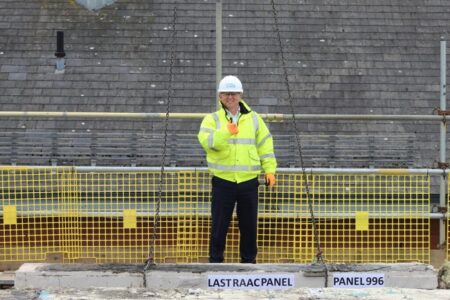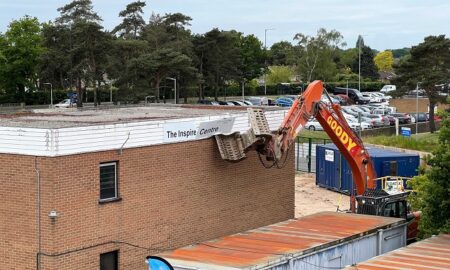Work continues to rid the NHS estate of RAAC
The Government has reiterated its pledge to rid the NHS estate of high-risk reinforced autoclaved aerated concrete (RAAC) by 2035.
In an updated statement issued last month, a Department of Health and Social Care (DHSC) spokesperson said significant additional funding of £698m was being spent to put in place necessary remediation and failsafe measures.
RAAC is a highly-aerated, lightweight, concrete-based material, with different material properties to conventional concrete and was frequently used in public sector building construction in the UK from the mid-1950s to the mid-1990s, typically in precast panels in walls, roofs, and sometimes floors.
However, it is known to be more vulnerable to corrosion than reinforced concrete, with problems including high deflection, corrosion, and spalling, and, where there is a low-end bearing, the possibility of sudden collapse due to cracking.
And this corrosion can occur without visual indication that the panel is in poor condition.
The DHSC spokesman said: “The NHS has an established a national programme to manage hospital buildings with confirmed reinforced autoclaved aerated concrete (RAAC), backed with significant additional funding from 2021-2025.
“We remain committed to eradicating RAAC from the NHS estate entirely by 2035 and our approach is in line with guidance from the Institution of Structural Engineers.
“Each site will be different – and just because RAAC is present, it does not necessarily mean there is a high risk.”
Inspections have been carried out, with a total of 42 NHS sites confirmed to have RAAC plank construction, according to the latest list published on gov.uk.
Through the national remediation programme, RAAC has already been completely eradicated in three of these sites.
In most identified cases, RAAC has been found in limited parts of a building.
However, seven of these hospitals need a full replacement and will be rebuilt by 2030 through the Government’s £3.7bn New Hospital Programme (NHP). These are Airedale, Queen Elizabeth King’s Lynn, Hinchingbrooke, Mid Cheshire Leighton, Frimley Park, West Suffolk, and James Paget hospitals.
For the other facilities, the Institution of Structural Engineers has published guidance on remediation and management strategies.
The approach will differ depending on the assessment of risk, but includes secondary supports or beams for the highest risk to inspection regimes for lower risk areas, as well as plans for limiting operational loads, such as no-walk zones on RAAC roofs and maintaining roof drainage, restricting new or removal of existing equipment, and reducing humidity.

Doncaster and Bassetlaw Teaching Hospitals was the first acute NHS provider in the country to fully eradicate RAAC from its estate. Andy White, the trust’s head of capital infrastructure, is pictured as the last panel was removed
Leading the way
Doncaster and Bassetlaw Teaching Hospitals (DBTH) was the first acute NHS provider in the country to successfully eradicate RAAC from its sites.
Following extensive surveys, it was found that the RAAC panels installed at Bassetlaw Hospital were in very good condition. However, they still had to be replaced as part of the national initiative.
As such, the trust received funding of £15.944m to replace the affected roofs by early to mid-2023.
The significant replacement works, undertaken in partnership with contractor, Integrated Health Projects (IHP), required theatres to be relocated into three temporary modular units which were placed in the existing car park outside the site’s clinical therapies department, with a link corridor into the main building.
And, throughout the project, theatre services on the Worksop site remained fully operational.
Dr Kirsty Edmondson Jones, director of innovation and infrastructure at the trust, said: “The removal of RAAC from Bassetlaw Hospital is a testament to our unwavering dedication to ensuring the safety and wellbeing of our patients, staff, and visitors.
“This achievement underscores our commitment to providing the highest quality of care in buildings which are fit for purpose.”
A three-year, £110m RAAC removal programme is also underway at The Queen Elizabeth Hospital King’s Lynn.
Led by Exi Group, the programme consists of enabling works and the relocation of existing users from proposed works areas; failsafe works to the underside of roof planks; wall protection works to vertical load-bearing RAAC planks, roof protection works, and statutory compliance works.

The Inspire Centre at The Queen Elizabeth Hospital King’s Lynn, which was constructed from RAAC, was demolished earlier this year as part of enabling works for a new hospital
